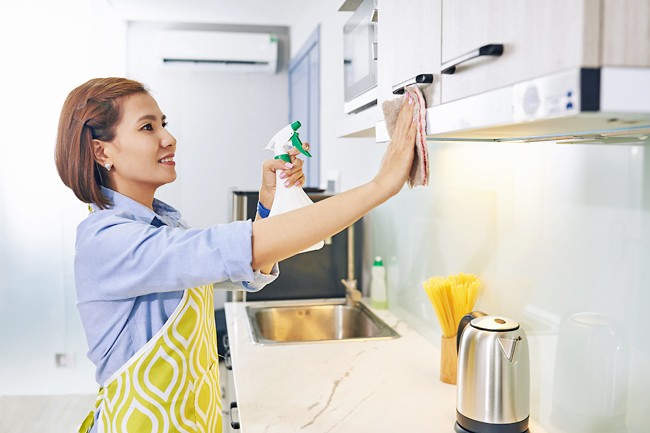Jeanne Huber
THE WASHINGTON POST – It’s tedious to clean greasy kitchen cabinets without harming them, especially of the wood veneer type. Most would just wipe them with soap, but that doesn’t seem to cut through grease.
Greasy residues are inevitable in any kitchen used for cooking rather than reheating ready-made meals. But removing the grime without damaging the cabinets can be tricky, partly because you aren’t usually trying to clean the wood itself.
Unless the finish has worn through, which sometimes happens around doorknobs or drawer pulls, the grease is on the finish.
But what type of finish do you have? Some cabinets with a natural-wood look have a traditional oil finish, such as tung or linseed. Most, though, have a clear coating, often over a stain. It might be alkyd varnish, polyurethane, lacquer, acrylic, conversion varnish or something else.
Margaret Novak, who, with her family, runs a Furniture Medic business in Virginia (restorefurniture.net) that occasionally takes on kitchen cabinet cleaning jobs, said the first step is ensuring the finish is intact. Pick a grimy place and scrape it with a fingernail, she said. “If you scrape and the finish comes off down to bare wood, you know cleaning will pull the finish off.” Forgo deep-cleaning unless you’re prepared to refinish the cabinets.

But if all appears well, prepare a cleaning solution. Soap is one option, but Christopher Brazie, technical services specialist in Sherwin-Williams Co’s industrial wood coatings division, said it’s “one of the worst” options. Because it’s difficult to thoroughly rinse a cabinet door or drawer after cleaning, an oil soap will probably leave an oily residue on the wood. “That works as a magnet for dirt,” he said, and you’ll need to clean much more frequently.
Instead, he recommended using a clear detergent made for hand-washing dishes.
Dilute whatever cleaner you use; for LA’s, use a quarter cup of cleaner to two-and-a-half cups water. Dawn recommended adding a few drops of detergent to a bowl of warm water for general cabinet cleaning. For stubborn areas, it says to squirt detergent directly onto a sponge or cloth while holding it under running warm water. Test the cleaner on a small, inconspicuous area before you commit to cleaning everything. Let the area dry, and inspect it under a bright light to ensure you didn’t change the cabinet’s sheen or colour.
Using warm water with the cleaner helps, because heat softens grease. But don’t make the water too hot, and be careful if you’re cleaning wood veneer. Heat and water can soften the adhesive used to attach veneer, and moisture can permanently distort particleboard, which is often used as a base for veneer.
Use a clean cloth or sponge to spread the cleaning solution. An old toothbrush can help get into corners. Avoid soaking the surface. Instead, clean only a small area at a time, and wring out the sponge or cloth before you wipe.
Immediately rinse off the cleaner and the gunk it loosened by going over the area with a fresh cloth or sponge moistened with water. Dry the area with a clean, soft cloth before you tackle the next area. Microfibre cloths or old terry-cloth towels work well, because they can pick up and trap a lot of moisture.
If these steps still leave dirty areas, you might want to repeat the cleaning. Novak recommended waiting for the area to dry thoroughly between cleanings, though, as insurance against introducing so much water that it soaks through the surface.
Be sure to clean the high-touch areas of cabinets frequently, Brazie said. In most kitchens, that means the front of the silverware drawer and the doors on cabinets that store glasses and plates. The beauty of using only a mild soap that’s pH-balanced – as hand-dishwashing detergents typically are to protect skin – is that it’s “multigenerational”, meaning it should work and not do damage whether you have cabinets that are 50 years old and coated with shellac or just a few years old and finished with the latest high-tech coating.
Some people recommend cleaning cabinets with mineral spirits to remove remaining grease. This is fine on most cabinet finishes, but mineral spirits can leave an oily residue, creating the same issues as oil soap, Brazie said. He doesn’t recommend it.
Even after this two-step cleaning, areas around knobs and pulls may still look dull or different from surrounding wood. Cleaning can’t fix these problems, but careful touch-ups can.


